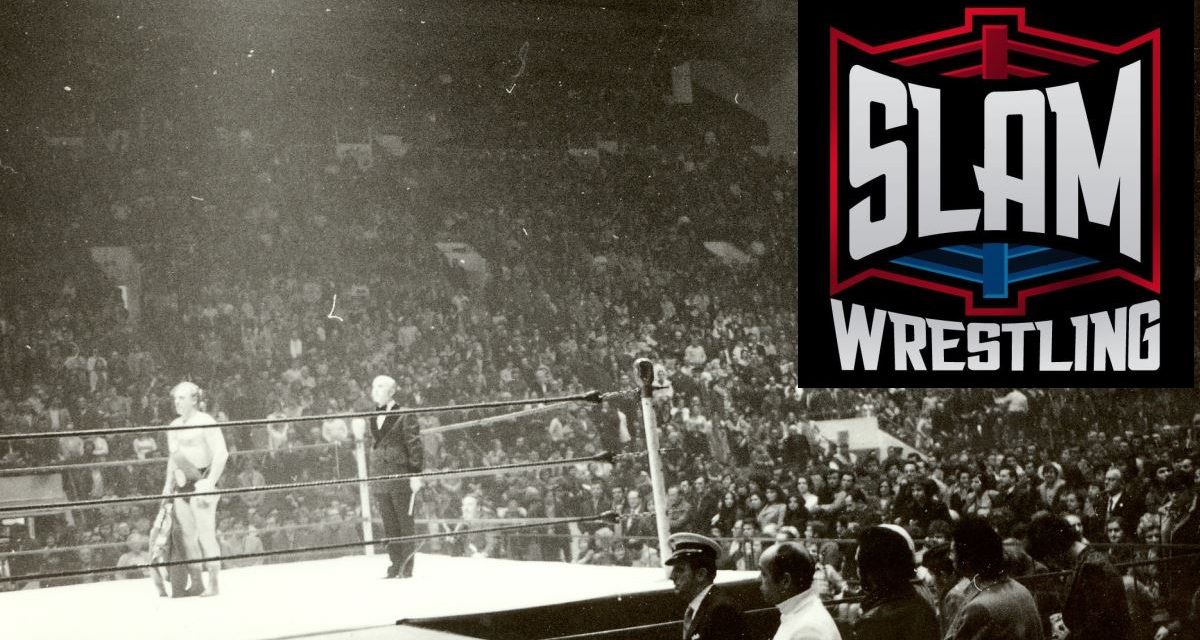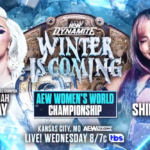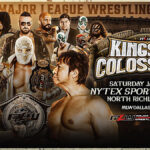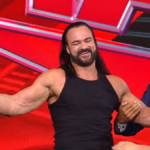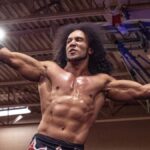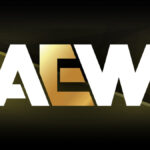In the 1970s in the Indianapolis territory run by Dick the Bruiser and Wilbur Snyder, Handsome Johnny Starr had the unique challenge of trying to replace Bobby “The Brain” Heenan as the area’s top heel manager.
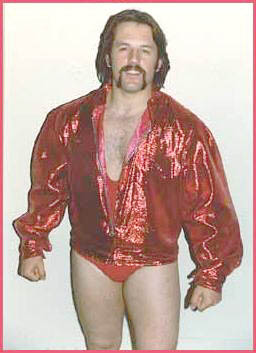
Johnny Starr in his heyday.
Reflecting back today, he’s okay with coming up a little short in comparison.
“[I’m] a guy that tried hard to replace Bobby Heenan and never quite got the job done. I understand that and I’m okay with that,” said Starr, or Reverend John B. Davis as he is known today.
The origin and development of a wrestler character and/or identity is very important for a wrestler just starting out. The believability of that character could make or break a newcomer.
“I created the character of Handsome Johnny Starr; although, I created it first as Gorgeous Johnny Starr. I came up here just as Bobby Heenan and Jimmy Valiant were leaving. This first time I wrestled up here under a completely different name,” recalled Starr. “You may not know this but I wrestled as Jocko Chino — the Chicago street fighter — in Wabash, Indiana. This was a different gimmick completely. The next match I went back to the Gorgeous Johnny Starr. Then they decided to give me a push as Heenan left. Dick was mad at Heenan for leaving, so he wanted to show that he could take anybody and replace him. So Dick figured I was anybody, but the name was changed to ‘Handsome’ Johnny Starr. I have no idea why.”
By 1974, “Pretty Boy” Bobby Heenan had almost a decade in the wrestling business, the majority of the time in the WWA. Heenan had become the predominant heel manager in the WWA with an impressive roster of clients. Now, young Handsome Johnny Starr was being positioned as the successor lead heel manager, which was a very challenging position and pressure situation.
“When I was a mark and before I ever got into the business, I was watching Bobby Heenan. I did then and still do think he was the best performer of his era as a manager type,” Starr gushed. “Bobby Heenan was Bobby Heenan in and out of the ring. That’s Bobby Heenan what you saw out there — the wise guy. He had an incredibly quick wit, was hilarious, and was the best.”
One the skills that Handsome Johnny Starr had to develop was his microphone skills for the weekly TV interviews promoting the upcoming wrestling events. The interviews for the Indianapolis territory were conducted by wrestling veteran Sam Menacker in videotape sessions that covered multiple towns. The interviews were instrumental in luring fans into buying tickets in and around the territory.
“You’ve got to be able to speak spontaneously cause you don’t have all day to rehearse,” explained Starr. “Right before you would go up, usually Bruiser would say to you, ‘Go up and do a shot for Terre Haute,’ as you are going to be wrestling whomever. You had to know what your context was and what your reference points were.”
As an English major at Indiana University at the time, Starr often spiced up the interviews with literary or mythological references.
The school/wrestling balance was a tricky one.
“I lived with a friend of mine in an apartment in Greenfield, Indiana. Nobody really knew I was in the professional wrestling business until I finally dyed my hair blonde,” laughed Starr. “This was probably the fall of 1974. I came to class one day and one of the girls asked if I had been out in the sun or what happened to my hair. I told them that I was a professional wrestler, and then a couple guys said that I looked familiar to them. That was about all the attention I ever got.”
One of the men that Starr managed was Ox Baker. Turns out some of Starr’s classmates were fans.
“Ox Baker and I got a letter from some guys at a dorm at Indiana University, and they didn’t know I was going to Indiana University. They sent a letter requesting a picture and said they stayed up Saturday nights watching wrestling on TV,” started Starr. “Well one Saturday, we were wrestling fairly close of Bloomington so I suggested to Ox that we get that picture, bring it to the dormitory, and give it to them. So we went up there, knocked on the door, and they were watching wrestling. They were drunk and high. They opened the door, and Ox and myself were standing there. You could tell that they thought reality was screwed up. We asked them if they were the guys who wanted the picture. I gave them the picture and left. I have no idea what their reaction was. I know they had to have scratched their heads after that.”
Starr wasn’t exactly the talk of campus. “Generally, I did not get recognized down there at Indiana University. I never had any problems and was never asked for an autograph. Sometimes, when I would go down to bars in Bloomington once in a while, the bartenders would send me free drinks all night in exchange for autographing a napkin. That was about the only privilege I ever got.”
Davis was born in Greenfield, Indiana in the early 1950s. His high school background was superb — twice the president of his high school junior and senior classes, the president of the student council his senior year, an all-conference fullback, a shot-putter on the track team, a member of the National Honor Society, and a selected delegate to the prestigious Indiana Boys State convention.
Yet that wacky world of pro wrestling always had an appeal.
“Well, from the time I was six years old I watched professional wrestling on TV, and Dick the Bruiser and Wilbur Snyder were young guys and big stars. I thought it was the greatest thing ever, and my brother and I watched wrestling on TV on Wednesday nights,” Starr said. “Wrestling was great theatre and it got us excited. That was my goal from the time I was six years old. When I was 20 years old, I realized there was the possibility of realizing it. Dick the Bruiser was my favorite growing up and the best. They used to do the shows in the smaller towns and came to Greenfield where I lived. I can remember my dad taking us, and later when I was in high school, we used to go to the Coliseum (Indianapolis) to watch wrestling. That was a lot of fun.”
Eventually, John was presented with opportunities to realize his long-time dream.
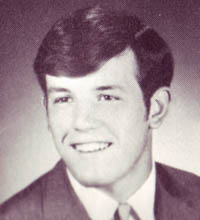
A young John B. Davis.
“I decided when I was 20 years old that it was time to get a plan. That summer, I made a lot of money selling advertising time for a local radio station and decided to see if I could sponsor a wrestling match here in Greenfield. I thought if I did that, then at least I could talk to these guys,” said Starr. “There was a guy named Dale Mann who wrestled here in the early days and was setting up the ring. We got to talking, he was training some guys, and I convinced him to train me. [Mann] went down to Kentucky to promote and needed wrestlers. Myself and a fellow named Max Blue got our break wrestling for Dale Mann in Kentucky. We went to small towns like Columbia and Russellville; these were some backwoods towns. My first opponent was Max Blue, the match was in Columbia, Kentucky, and I guess we made $25 a piece. It was a long trip down there and back on March 10, 1974.”
After getting some experience with Mann’s independent show, John set his eyes on Indianapolis territory — but not as a wrestler or a manager.
“Oddly enough, there was a promoter in Kentucky who convinced me to try to get a promoter’s license up here. He thought because my dad was a judge and a bigwig in the Democratic party that I could get a promoter’s license. So I came up here and talked to Kelse McClure who was the head of the State Athletic Commission. To protect Bruiser and Snyder, he said he would call Bruiser and Snyder to see if I could start working for them. He was right and I lost my interest in getting a promoter’s license. He used some leverage, and then I agreed not to pursue to promoter’s license.”
At a young age, Starr was traveling the WWA circuit, hitting major towns in Indiana such as Fort Wayne, Elkhart, Hammond, Terre Haute, and Indianapolis, plus sharing the bill at the International Amphitheatre in Chicago with Verne Gagne’s AWA. Certain cities stood out as the best place and the worst place to work.
“The best, without a doubt, was Chicago, because Bob Luce was the best promoter of his era. Bob Luce was 20 years ahead of his time. Had he had the funding, he would have ended up doing what Vince McMahon (Jr.) did. Bob Luce understood this is show business and he just got that,” Starr said. “You know, Verne Gagne kind of wanted this to be wrestling; well, it is not wrestling — it is show business. That is what Bob Luce understood more than anybody, and it was fun. There were a lot of great guys up there and you saw a lot of talent. Chicago is a great city as we would get up there early, go to a nice place to eat, and see where the nice looking girls were. I was single at the time back then. The least favorite city was Terre Haute without a doubt. People there would interfere in the matches. I got into fist fight with somebody at ringside and cold cocked him. I thought I was going to get sued but fortunately I didn’t. That was a dangerous place to be.”
Starr has fond memories of the line-up of distinguished roster of referees that worked the WWA territory in the mid 1970s. Just like the other territories, the fans took a liking or sometimes a disliking to these overlooked members of the cast.
“Johnny Shorn and me were great friends. He was from Plainfield where my wife was from. I liked Johnny Shorn and he was a good guy. Shorn and I traveled together a lot. Connie Marker was a character and had a restaurant in Richmond (Indiana). Whenever we wrestled in Richmond, he had a back room (at the restaurant) with all the wrestlers over, and he would put out a big Greek meal. That is where I introduced to Greek food for the first time. Bob Wingo was another good guy who was badly hurt in an accident. Some type of a spring flew off a railroad car and hit him in the face, breaking every bone. He was nearly killed but did come back after that. He got a huge settlement from the railroad. They were all good fellows.”
Every wrestler has that big break that helps propel them higher up on the roster and into more important matches and programs. Johnny Starr’s opportunity after in a series of matches against the co-owner’s son — Mike Snyder, the son of Wilbur.
“I don’t know exactly how it came about, but I had been wrestling for about four months primarily as a jobber. However, Mike Snyder and I had a series of good matches. I think I established myself as a pretty good worker, and Dick liked guys who were reliable. Since Heenan quit on him, making me a manager had more to do with showing Heenan that he could replace him.”
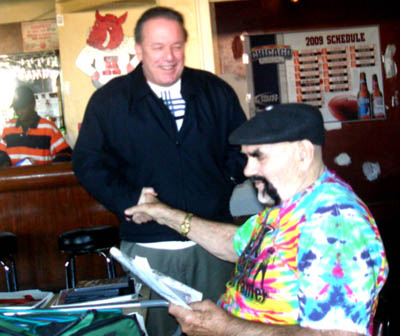
John B. Davis is reunited with Ox Baker a few years back.
Pretty soon Handsome Johnny Starr found himself managing wrestling’s notorious heartpuncher, Ox Baker, in the WWA territory. Earlier in January 1974, Ox Baker attracted big attention in the wrestling world as he was part of a big fan riot that erupted at the old Cleveland Arena after his repeated heart-punching Ernie Ladd. Eventually, Dick the Bruiser and Snyder brought Baker to Indianapolis to work the circuit.
“It wasn’t that Ox needed a manager. I don’t think that was it. I didn’t really know Ox. Then first time I saw Ox I wrestled him at the Convention Center. I thought it was a tremendous break, and I was really excited,” said Starr. “Ox and I became great friends as he was such a character. I really didn’t manage Ox. It was an act. We did whatever the promoter or booker told us to do that night. You were always subject to what they wanted you to do. We would talk about ‘blood quota’ and other verbiage for the interviews.
“I’ve got to be honest, most of us guys talked about where the good-looking girls were in the towns; we were more concerned with that than the matches. I remember the first time in Chicago as Ox and I were walking from our car to little delicatessen near the TV studio. There were a couple of fellows up a ladder painting a building, and Ox got to the bottom of the ladder and started shaking it. They got madder than heck at him. I thought he was going to shake them off the ladder. That was a rough introduction to Chicago. Ox would do just about anything — the most unexpected things. You had to be ready. Sometimes it was embarrassing but sometimes it was hilarious. You never knew what he was going to do.”
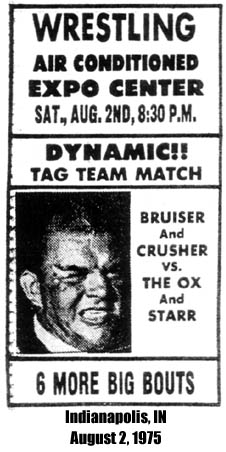
On occasion, Starr would be in tag matches with Ox as his partner. Starr was surely progressing with his in-ring skills and that improvement warranted inclusion into some main events in the territory.
“The great memory for me was teaming with Ox at the Convention Center against Dick the Bruiser and The Crusher in August 1975. I can just remember just driving over to the Convention Center that night and thinking, ‘Wow, I am going to be in the main event with Dick the Bruiser, a guy that I thought as a six year old was God.’ It was a trip. It was always interesting working with Ox. I don’t remember how many times I teamed with Ox, but it wasn’t that often.”
Starr went through some of the cast of characters that he worked with during those years in the WWA under Bruiser and Snyder.
Mike Snyder: We had some good matches that even the other wrestlers would talk about because we were both smaller guys and were flyers. We were both athletes, but Mike was by far the best overall athlete. It was great working with him. We had a lot of fun because you could do a lot of things. He was willing to sell you. Those matches with him did more to launch my career than anything I can think of. Mike was a real good tennis player. He was good at everything. I think Mike went to California, and I think, the last time I heard, he might have been somehow involved in TV production. I couldn’t swear to that. I don’t think Mike liked being in the wrestling business. He always seemed kind of unhappy. Of course, he was really small but he was a worker.
Pepper Gomez: Pepper was a good babyface, and he and Heenan had had great matches with a lot of heat. I felt pressure to try to recreate that heat, but Bruiser always wanted to hold back the other babyfaces. He (Bruiser) would only let Pepper get so hot. Pepper was good to work with and was good worker. He would let you get your heat. He made great comebacks. He just got over great. It was always fun to wrestle a babyface who knew how to get over and who would let you develop you heat. I always enjoyed it. Strap matches were difficult because you had limited mobility and couldn’t do the flying. You couldn’t do much coming off the ropes, so they were harder to work I thought.
The Chain Gang (Don Kalt and Kenny Mack): And I will tell you the greatest tag team I’ve ever seen, that was ever in the business, was a pair called The Chain Gang, including Donnie Fargo. You know I managed Fargo (years later) as part of the Legionnaires. But he was, years before I got in the business, part of the Chain Gang. They were outlaws, motorcycle gang guys, and really hung around with the outlaws. Donnie was a wild man. He was a crazy man, and so was his partner. They were tough sons of guns. Finally, the real outlaws figured out they weren’t really outlaws and beat them half to death one night. They shot Kenny (Mack) six or seven times and crippled him. It was an awful thing. Man, when they were working, I never saw a tag team get more heat than those guys did. In my opinion, there wasn’t another tag team that generated that kind of heat.
Lou Thesz: I have kind of a dualistic memory in that I hated working for Lou because I didn’t know what to do with him. You know he was a very technical wrestling and knew all the amateur-type moves. It was hard and I didn’t know how to work with his style. On the other hand, he may be the favorite human being that I ever met in professional wrestling. He was a bright guy and a good bridge player. He was an intelligent and articulate man, and could talk about everything. We traveled together a lot, and I would pick his brain about wrestling in the 1930s and 1940s. He was a great guy. I had a lot of respect for Lou. He called me after he left this territory. He and some other guys, including Don Kent of The Kangaroos, were starting a territory in the South. He called me and wanted me to come in and work, but I didn’t go because I like being up here. That was the greatest compliment ever paid to me in the wrestling business.
Wilbur Snyder: I liked Wilbur but working with Wilbur was hard because Wilbur was an old school guy who did the holds. This was the stuff that looked like wrestling, but I know nothing about. It was harder to work with Wilbur. I liked Wilbur by the way as he was one of the really nice human beings.
Chuck “The Monster” O’Connor (later Big John Studd): John (Minton) and I were good friends. He was college graduate. I think he went to Kansas State and played basketball; it could have been Kansas. He had been a prison guard at Leavenworth Prison for a while. He was one of the most legitimately tough guys in the business. He was a nice guy and he and I got along beautifully. He hated Ox Baker, and lot of people did not like Ox. Monster, and I always called him Chuck, was a real good guy. I didn’t think he would be a big star as I thought his interviews weren’t super good and he was a little short on charisma. He worked on that and he got real big (in later years). After he made it big with the WWF, I would go up and see him in Indianapolis. He would hug me, treat me nice, and have a nice chat. Well, some of those other wrestlers just turned their back on us territory guys. He was always a nice guy and we traveled and partied together. I don’t know if you knew this but his wife, Michelle, was the original Dodge (Automobiles) girl when they used to have those Dodge ads in the 1960s and 1970s. She was an actress and that was her big commercial. Of course, they ultimately got divorced but she was real nice. He and Ox got in a fight one time in the dressing room at the Convention Center. After a match, when you are walking back to the dressing room, is a very dangerous time. People are worked up and you are vulnerable to getting stabbed or punched. While we have cops around us, it is important to walk straight back and not stop to give people a shot at you. Well, Ox would stop and that would make Chuck mad. He told Ox several times not to do it. Ox then did it twice and in the dressing room, Chuck told Ox not to do that again, and Ox told Chuck to “f— off.” Ox was sitting down on a bench that was bolted down into the cement floor. Chuck kicked Ox so hard that it lifted Ox up and pulled that bench out of the cement. He went after Ox. I was jumping on Chuck’s arms just trying to keep him from killing Ox. He was literally punching Ox with me hanging on his arm. Finally, Moose Cholak, Bruiser, and some guys came over a broke it up. They were not friends.
Blackjack Lanza and Bobby Heenan: The match I remember up there [in Chicago’s International Amphitheatre] that just blew me away was when Ox wrestled Blackjack Lanza. I managed Ox and Heenan managed Lanza. We turned out to be the babyfaces that night. The crowd just went berserk. Heenan tried to interfere and I kept him out. Here’s the thing — we could have done something with that if they would have brought Heenan and me back. But then again, Dick and those guys didn’t want anybody else to get over, so they just let that die. The crowd just ate it up. That’s one I do remember.
Moose Cholak: Moose was big and nice giant of a man. A wonderful and first class guy. And a tough son-of-gun. I tell you legitimately tough. Every so often, we would have things where everybody piled up on a guy in the middle of the ring. I tell you — you could get hurt doing that. I said to Moose one time, because I knew that would be the finish and on the bottom, ‘Moose, I am going to get killed and you cannot just lay on me like that cause I can’t breathe.’ Well, Moose is on me and three other guys pile on, and I said, ‘Moose, I can’t breathe.’ He just lifted up with his arms and got that whole pile off of me. Now that’s a strong man and I appreciated that.
Paul Christy: If you were ever going to have a party, you had to invite Paul Christy. He was the most delightful and even tempered fellow. He was a great worker. I always had great matches and looked forward to matches with Paul Christy. It was a night off and he was a great guy.
The Crusher: I think he was one of the most genuinely people in the business. I didn’t know anybody who didn’t like him. He was nice guy but was a tough son-of-gun. He really was. The only time I would see was when he came to Indianapolis or when we would go the Chicago shows. I used to sit there and talk with him. From what I know of him, he was a good family man.
Guy Mitchell/Jerry Valiant (Jack Hill): He and I were really good friends, even outside the ring. We were friends years after I got out of the wrestling business. He and his wife and my wife would go places together. He went to New York (as the third Valiant brother), but he had a bad back that started to bother him. I think he also used to run the ring for the WWF in their early years, and did very well with that. He was in his late 40s and didn’t want to wrestle anymore.
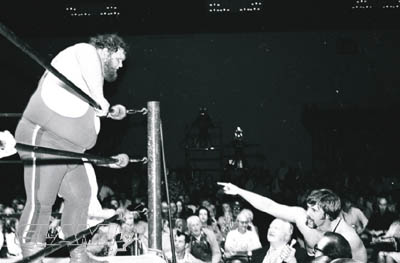
The massive Chris Taylor looks down at Johnny Starr. Photo by Scott Romer, http://www.scottromerphoto.com
Starr does have a few moments from his career that he would like to have back. While Starr had a relatively quick journey to managing and wrestling in main events, there were some less than favorable moments along the way.
“On one website I saw, years ago I hit Ernie Ladd with a chair (at Market Square Arena with Starr managing Ox) and it was horrible. It was just bad. Then there was another interview I did where I was hitting Ox with a chain (WSNS-TV Channel 44 in Chicago) and that was horrible. I see those things and wonder how I stayed around long enough, but I did. It was all a work, you know.”
During his career, Starr only made one real trip outside the Indianapolis territory, to Memphis, where he went down with Jack Hill.
“Their territory was known as a pretty good territory for a smaller guy, and you could make more money down there than you could up here. I called them and sent them some pictures. Then Jarrett, I can’t remember if it was Jerry or his mother, called me back said they want me to come down as a babyface. This is something that I should have never done because I was horrible babyface, but I did,” Starr said. “I went down there on a Saturday and worked two or three matches on TV. I don’t remember who I worked against but I did a blade job. I beat somebody who was a favorite down there. Then that night, Jerry Lawler and I were partners against some big Russian guy and maybe one of the The Moondogs. We went over.
“Then I was supposed to wrestle for the Mid South championship that Monday. I don’t know that it was about wrestling in Jonesboro, Arkansas, but remember standing in that ring and looking out at that crowd in that small arena. I then thought, ‘Hey, I’ve got a college education and here I am in this dump — wrestling for these people for next to nothing.’ I said that’s it and I am not going to do this anymore. I got my payoff and drove back to Indianapolis and quit. That is how disgusted I was with the business at that point. I didn’t want to do it anymore.
After Ox Baker departed from the Indianapolis territory, Starr had a short run with Handsome Jimmy Valiant as his tag team partner. Jimmy was on a hiatus from Luscious Johnny Valiant and back in his native Indiana territory.
“Johnny (Valiant) was in New York and I think Jimmy was in the South for a while. I came back (to Indiana) after the Memphis visit but then was without a job,” Starr said. “They had already moved Duke George into the manager’s position. Jimmy Valiant was here, but Dick decided to put us together. I remember that Valiant and I really clicked. We had some good matches, but I really wasn’t interested in pursuing it anymore. I had a good job outside of wrestling, and there was too much travel. That would have been the time in my career, if I said that I would just put it all in and had Jimmy Valiant wanted to continue, I think we could have maybe done something.”
One of the last matches in Indiana listed for Johnny Starr was in May 1977 in Columbus, Indiana, was against Steve Regal, who also was the son-in-law of Wilbur Snyder.
“That could be. I had a real falling out with Dick the Bruiser. I actually did get a promoter’s license which didn’t put me in favor with him. Later when Spike Huber (who married Dick the Bruiser’s daughter Michelle in 1974) divorced Dick’s daughter, had his falling out with Dick, and then started his opposition promotion, I went to work for Spike. One other time, I called Bruiser on the phone and said I wanted to come by and just to see some guys at a match. He didn’t want me to come by and had somebody posted at the door to keep me out, but I still got in to talk with some guys. We ended things on a bad note.”
Years after his wrestling career and the Handsome Johnny Starr character, John B. Davis began a new career, something several other ex-wrestlers have pursued.
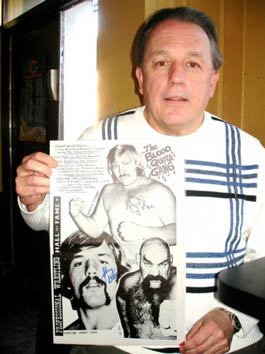
Reverend John B. Davis poses with some memorabilia in late 2009.
“I am a minister in the Disciples of Christ Church denomination and have been since 2000. I was first located at Greenfield where I was born and raised. I was called to Greenfield Christian Church and it all happened in my life around 1990,” Starr said. “I had a small television station and concurrent with, had a call all my life from God, and it took ten years to respond to it, but finally did. I went to the seminary in 1999 and graduated from Christian Theological Seminary with a Masters of Divinity degree. I got the assignment in my hometown at and did not know how it would work because people would know that I was a professional wrestler. I wondered if anybody would buy me as a minister but actually, it was been really great.”
Early in 2010, John transferred to First Christian Church in Nobelsville, Indiana, with one of his goals being the growth of the congregation going forward. This is same church where John says he got his calling to the ministry.
Stacy Davis, his wife for over 20 years, commented on her husband in his pastoral role.
“John enjoys the challenge of bringing new life to a church congregation that may be struggling. That energizes him — to bring back life and infuse spirit into the group again,” she said. “Considering his persona in the wrestling field, he is a very caring person and very dedicated to helping people. His wrestling experience made him more comfortable in front of a group, and he’s more animated than just standing behind a pulpit. He is able to talk off the top of his head, something he had to do in professional wrestling in front of television cameras.”
While the Reverend John B. Davis did not have a long career in professional wrestling, he did rise to main event levels in the WWA relatively fast and performed in the respected Bruiser/Snyder organization while it still had some hot moments. John has given some thought as to how he wanted to be remembered.
“When I was in the business, I tried to treat people nicely, both people outside the business and inside the business. I guess I want to be remembered as a nice guy, credible worker, and a credible mouthpiece. And if that happens, I will be happy.”
